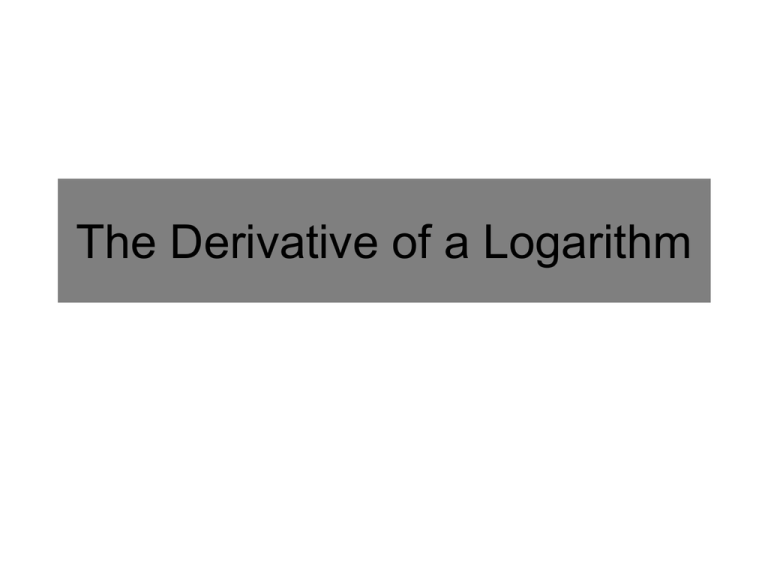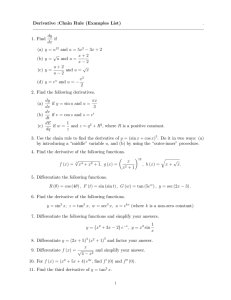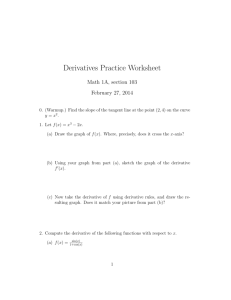The Derivative of a Logarithm
advertisement

The Derivative of a Logarithm The Derivative of a Logarithm If f(x) = loga x, then d 1 log a x dx ln a x Notice if a = e, then d 1 ln x dx x The Derivative of a Logarithm If f(x) = loga g(x) and g(x) is differentiable, then g ' x d log a g ( x) dx ln a g x Notice if a = e, then g ' x d ln g ( x) dx g x Examples Find the derivative of each function: a 10 & g x x a. f x log10 x d dx 1 x f ' x ln10 x x ln10 b. h x ln g 'u d dx sin x ln e sin x sin x 1 2 sin x a e & g x sin x 1 2 sin x cos x cos x 1 cot x 2sin x 2 Example 2 Find the derivative of: y ln x 1 2 x 9 7 y ln x 1 ln 2 x 9 7 You CAN use Logarithm Laws to expand to simplify finding the derivative. y 7 ln x 1 ln 2 x 9 Now take the derivative y' 7 1 x 1 y' 7 2 x 9 x 1 2 x 9 y' 2 2 x 9 16 x 65 x 1 2 x 9 2 x 1 x 1 2 x 9 Example 3 Find the derivative of: Rewrite as a piece-wise function. y' y' y ln 2 x 1 ln 2 x 1 , x 0.5 y ln 2 x 1 , x 0.5 Now take the derivative of each piece 2 2 x 1 2 2 x 1 y' Equal y' 2 2 x 1 2 2 x 1 Example 3 (Generalized) Find the derivative of: Rewrite as a piece-wise function. y log a u log a u , x c y log a u , x c Now take the derivative of each piece y' u ' ln a u y' u' ln a u y' u' ln a u Equal y' u' ln a u The derivative of each piece will always be equal The Derivative of a Logarithm Composed with an Absolute Value If f(x) = loga │g(x)│ and g(x) is differentiable, then g ' x d log a g ( x) dx ln a g x Notice if a = e, then g ' x d ln g ( x) dx g x Ignore the Absolute Value. White Board Challenge Is the function below differentiable at x = 0? e , x 0 f x 2 x 4 x, x 0 4x No, lim f x 1 but lim f x 0 x 0 x 0 It is not continuous at x 0. Example 4 Find the x 12 2 x 2 3 If it is very derivative of: complicated or 2 x 1 impossible… 2 2 x 1 2 x 3 Take the natural log of both sides to expand the complicated quotient/product. x 2 1 2 2 1 2 Now take the derivative of both sides. ln f x ln f x ln f x 2 ln x 1 ln 2 x 3 ln x 1 f ' x f x 2 f ' x 2 f ' x 2 x 1 1 x 1 1 x 1 4x 2 x 2 3 4x 2 x 2 3 2x Solve for f ' 2 x 1 2x 1 2 x 2 1 2 2 x 1 2 x 3 2 x42x3 x2x1 1 2 f x x 2 1 Logarithmic Differentiation 1. Take the natural logarithm of both sides. 2. Simplify the “x” side using the properties of logarithms. 3. Differentiate both sides of the equation. 4. Solve for y'. Example 5 Find the derivative of: x ln y ln sin x ln y x ln sin x y sin x x Take the natural log of both sides. x is in the base and exponent, so power and exponential rules do not apply. Now take the derivative of both sides. x ln sin x y ' x cot x ln sin x y y' y cos x sin x Solve for y ' y ' x cot x ln sin x sin x x 1982 AB Free Response 5






